Choosing the best mountain bike for your riding is vital if you want to get maximum enjoyment out on the trails – but finding the right bike in a crowded market can be a minefield.
Fear not, because our ultimate guide to buying a mountain bike will run you through all you need to know, from choosing the best machine for your budget to matching a bike to your riding style.
Our tech writers have tested hundreds of mountain bikes over the years, ranging from budget hardtails to the most extreme downhill bikes on the market.
Mountain bike design is one of the fastest-evolving areas in the industry, with bikes looking barely recognisable from those made 20 or more years ago, and frame designers free to experiment, unlike rigid UCI-regulated road bikes.
Recently, there’s been a huge surge in electric mountain bikes, with the addition of battery-powered electric bike motors bringing new elements to the sport.
At the middle and top of the market, it's not uncommon to see full-suspension carbon fibre frames and electronic gearing, while the entry level usually features hardtail metal frames matched to suspension forks. But, whatever their price, mountain bikes are designed to get you out on the trails and experience the joy of whizzing between the trees.
Because mountain biking is so multi-faceted, we have split this list into discipline categories and provided our entry-level top picks, so there should be something for everyone. You can skip to these categories using the links below:
- Best trail mountain bikes
- Best cross-country mountain bikes
- Best enduro mountain bikes
- Best electric mountain bikes
- Best hardtail mountain bikes
- Best downhill mountain bikes
- Best budget mountain bikes
We’ve also included our in-depth mountain bike buyer's guide, which details everything you need to know about mountain bikes so you can find the right bike for you.
Editor's note: this list was updated on 4 February 2025 with bikes from our recent group tests, including the Whyte T-160 RS, Atherton Bikes A.150.1, Cannondale Scalpel 1 Lefty, Specialized Epic 8 Pro, Orbea Rise LT M-Team, Fairlight Holt XT and Saracen Myst Pro.
Best mountain bikes 2025
Best trail mountain bikes
The best trail bikes balance the trail-conquering characteristics of an enduro bike with the pedalling efficiency of a cross-country bike. They're incredibly popular for their wide-ranging ability.
Whyte T-160 RS
SQUIRREL_TEXT_13184540

- £2,999 as tested
- Pros: Impressive flat-out descending performance; impressive value; decent climbing ability
- Cons: Seat angle could be slightly steeper
Whyte's T-160 RS impressed us so much in testing that we awarded it the title of Trail Bike of the Year 2024.
The British brand has put together a bike with almost unbelievable value, with a RockShox Lyrik Ultimate fork and a Super Deluxe Ultimate RC2T shock used for suspension.
We found the T-160 RS to eat up rough ground with a calm capability, thanks to the sophisticated suspension.
It's not the lightest bike, at 16kg, but it climbs with a reassuring efficiency – although we'd have appreciated a slightly steeper seat angle.
SQUIRREL_13184540
Atherton Bikes A.150.1

- £7,900 as tested
- Pros: Excellent suspension; balanced and efficient ride feel; plenty of customisation
- Cons: Pricey
The A.150.1 uses Atherton's additive construction, which sees carbon tubing bonded to 3D-printed lugs, allowing for custom geometry and 22 stock sizes.
We found the DW6 suspension linkage to be excellent, smoothing out chunky terrain even when going flat-out.
Its geometry is well-balanced and, in combination with the suspension, leads to an incredibly composed ride feel.
The A.150.1 is on the expensive side, but for a bike that's near-bespoke, that's not surprising.
While the spec is functional, it isn't as fancy as other bikes in its price range.
Cannondale Habit 4
SQUIRREL_TEXT_13096010
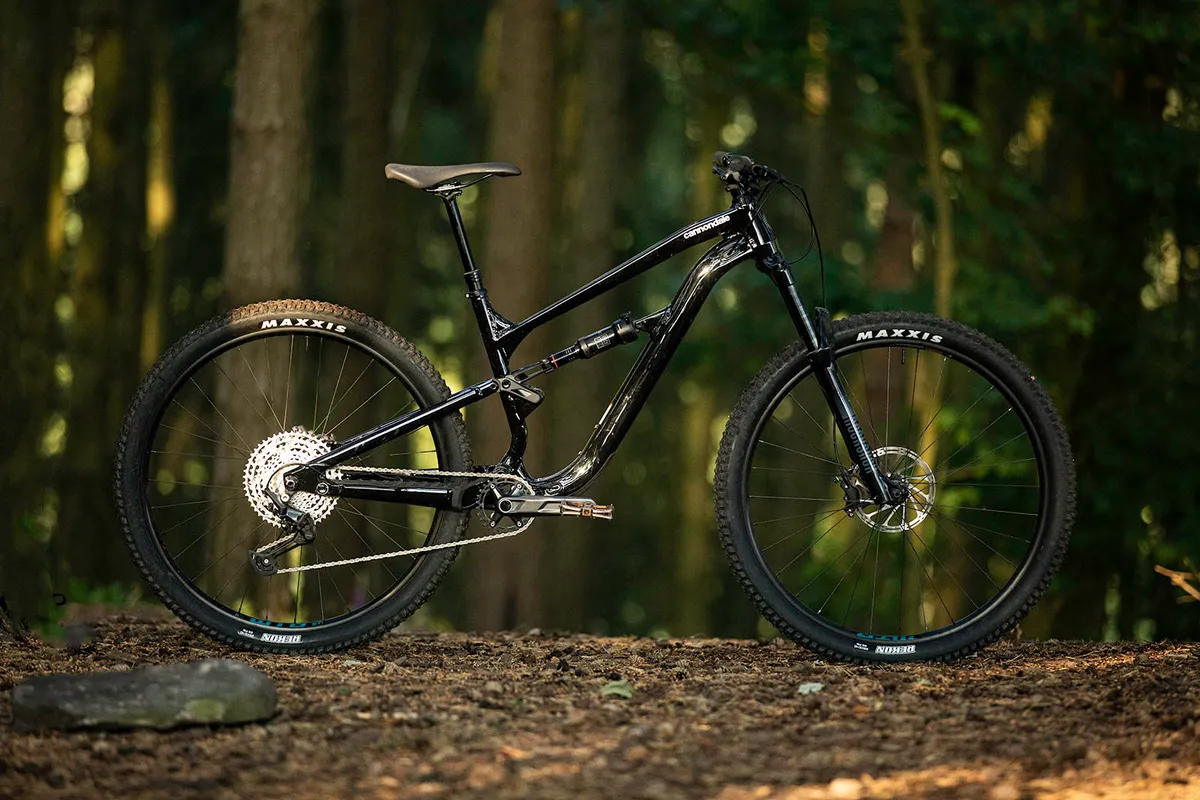
- £2,300 / $2,300 / €2,699 / AU$4,399 as tested
- Pros: Well-balanced; confidence-inspiring ride; fun and flicky
- Cons: Shimano Deore drivetrain can be a little clunky
The Habit 4 impressed us with its playful and balanced ride that is sure-footed and quick to turn when pointed downhill.
Its aluminium frame features size-specific geometry, with the chainstay length increasing through the size range.
The RockShox Recon fork tended to bind on hard compressions, but this didn't take much away from the bike's overall performance and highlights how competent the frame is.
Its steep seat tube angle of 77.5 degrees makes climbing comfortable, though it's not the most efficient we've tested.
SQUIRREL_13096010
Canyon Spectral CF7
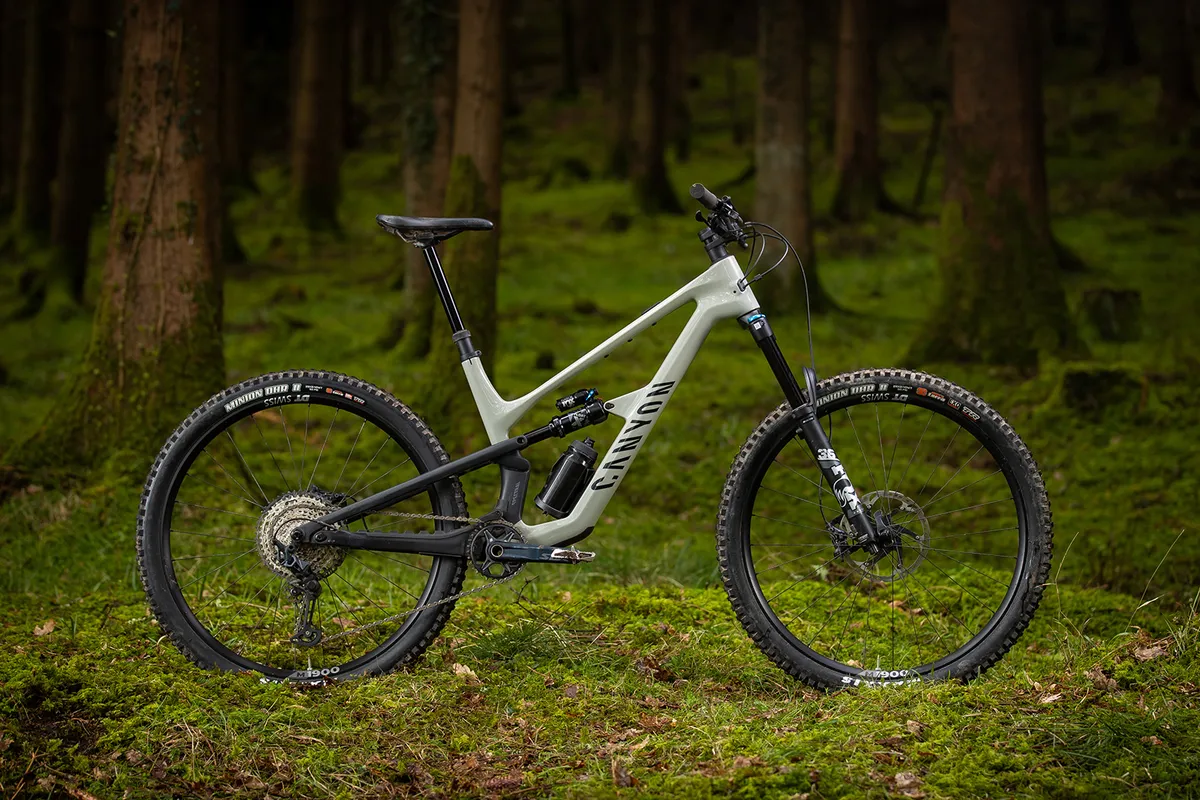
- £3,299 / $3,699 / €3,449 / AU$5.249 as tested
- Pros: Playful ride that's stable at high speed; smooth and comfortable; well-considered geometry
- Cons: Fork could be more supportive for aggressive riding; down tube storage doesn't feel the sturdiest
The Spectral lives up to Canyon's claim of having a do-it-all DNA, with the bike offering impressive ground-covering ability for all-day cruises and a geometry that leaves nothing to be desired on the descents.
It's fun to ride, while remaining calm and capable when ploughing through rough sections of trail. This is helped in part by Canyon's KIS (Keep It Stable) system, which uses a pair of springs to connect the top tube and fork steerer.
For the money, the bike represents exceptional value, with a carbon frame and fantastic spec list sealing the deal.
While the Fox Rhythm 36 provided an easy setup, we felt it could be more supportive for aggressive riding.
Norco Fluid FS C2
SQUIRREL_TEXT_13123899
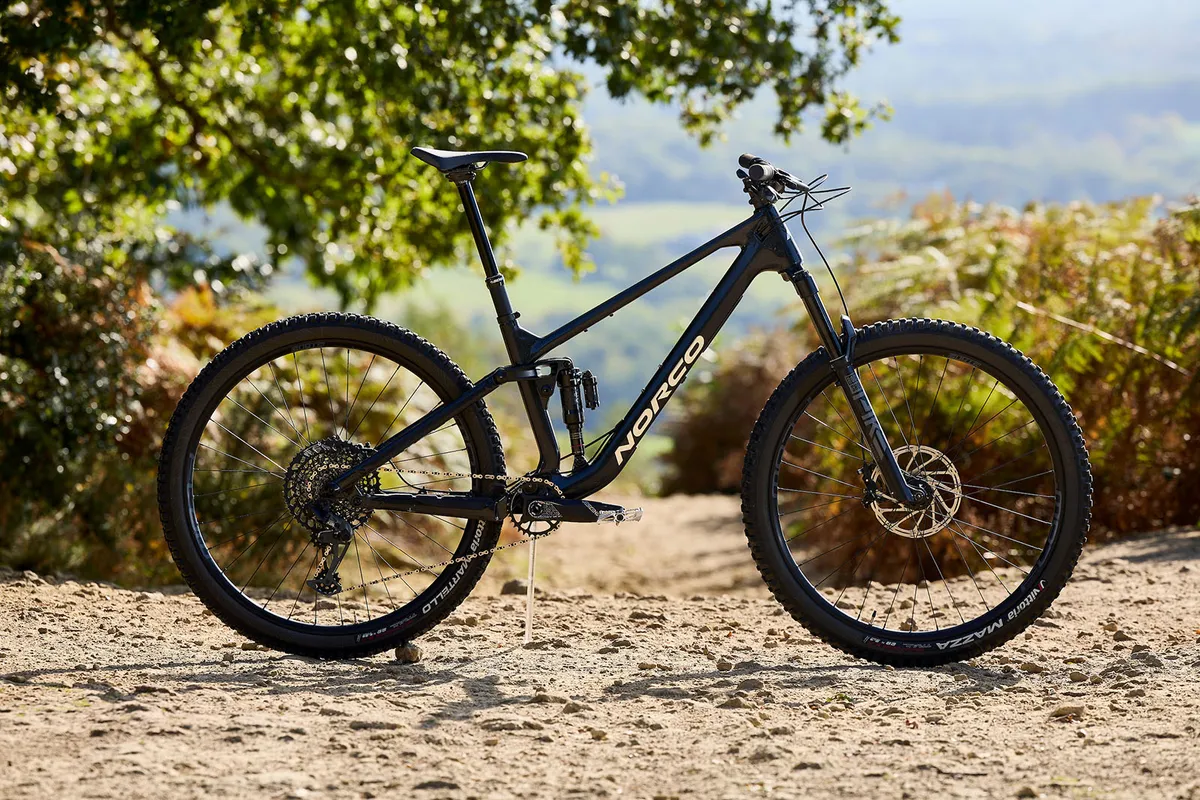
- £4,999 / $4,999 / €5,299 as tested
- Pros: Confidence-inspiring geometry; makes good use of suspension travel
- Cons: Brakes could be more powerful; tyres won't suit everyone
Norco's Fluid FS C2 has great agility on the trail, while remaining calm and collected at high speeds.
The bike feels planted through rough terrain, with its 140mm RockShox Pike Select+ fork and Super Deluxe Select+ shock taking care of trail imperfections without feeling wallowy.
On the hills, it impresses, with an eager efficiency that makes you want to race up every slope.
We felt the SRAM G2 RS brakes were a little underpowered in some situations, with the bike suiting beefier stoppers.
SQUIRREL_13123899
Best cross-country mountain bikes
The best cross-country mountain bikes often feature svelte, lightweight frames with 100 to 120mm of travel for racing up hills and flying down descents. In recent years, bikes have become more aggressive to cope with ever-more challenging XC courses.
Cannondale Scalpel 1 Lefty

- £8,550 / €9,499 as tested
- Pros: Great geometry; solid spec list; Lefty is smooth and stiff
- Cons: Carbon rims are on the stiff side; Lefty may be divisive
Cannondale's Scalpel 1 Lefty offers impressive responsiveness and downhill capability thanks to a sorted frame that puts it at the sharp end of the latest cross-country crop.
While functional, we found the spec list to be shy of high-end components you'd usually find at this price point.
Its latest-generation Lefty fork is smooth into the travel and solid in high-load corners – it's also nearly impossible to clog with mud.
The bike soaks up impacts well and the 120mm of travel makes it a pleasure to ride on a variety of trails.
Specialized Epic 8 Pro
SQUIRREL_TEXT_13121634

- £8,000 as tested
- Pros: Incredibly efficient; trail-bike handling; quick lockout
- Cons: Round tyre profile becomes unsettled on some surfaces
The Epic has been the benchmark cross-country bike of the past decade, with the latest-generation Epic 8 setting the bar even higher.
It is capable on almost all trails, with the handling and suspension feel similar to a trail bike.
We found the three-mode lockout performed well, with the middle setting making for a great pedalling platform with plenty of grip and support on tap.
We were less impressed by the Fast Trak front tyre, which led to some squirrelly moments, with the round profile making the front of the bike dive when cornering.
SQUIRREL_13121634
Trek Supercaliber SLR 9.9 XX AXS Gen 2
SQUIRREL_TEXT_13184547
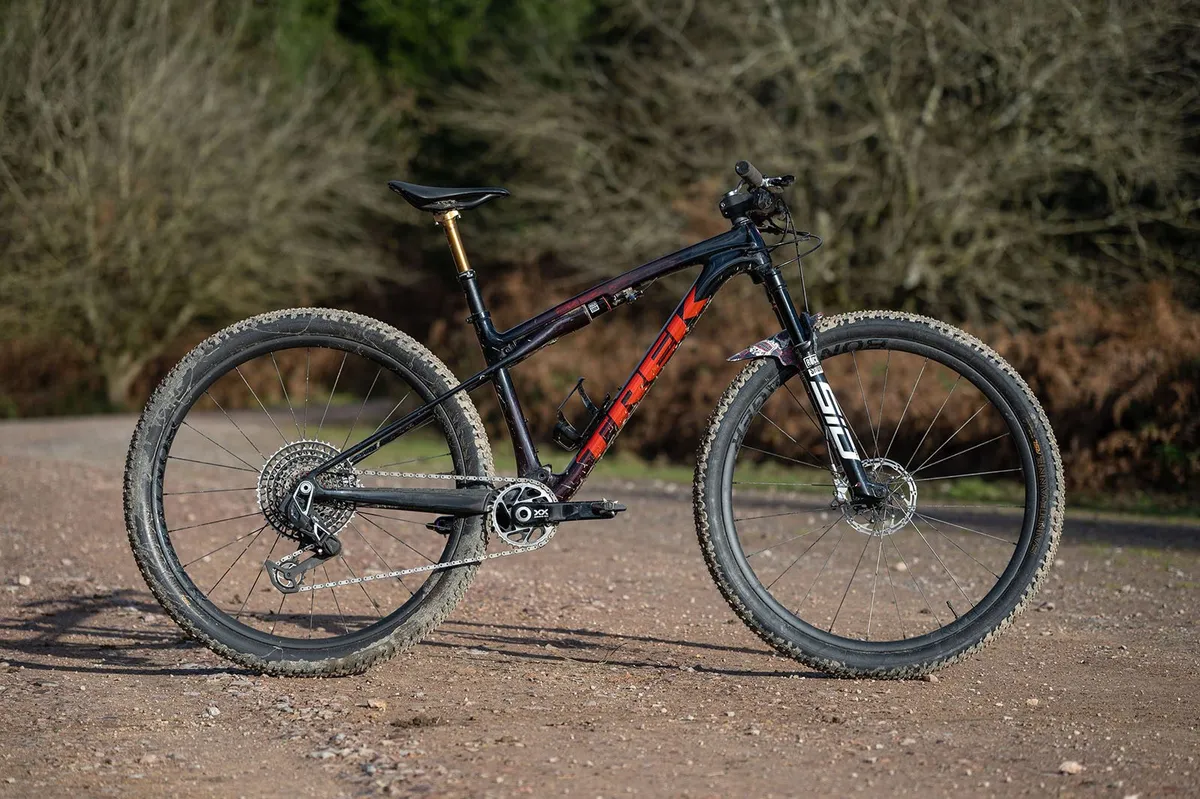
- £10,800 as tested
- Pros: Direct feel with capable geometry
- Cons: One-piece bar and stem, plus narrow tyres
The Supercaliber SLR 9.9 XX AXS Gen 2 is race-bred, and delivers sharp handling and efficient power transfer.
The IsoStrut rear shock, partially hidden in the top tube, offers the efficiency of a hardtail with the comfort of rear suspension.
A well-balanced and capable geometry makes the bike feel confident going downhill, but it really shines on the ups where its ground-covering ability is highlighted.
In pursuit of speed, Trek has given the Supercaliber skinny 2.2in tyres that don't quite cut the mustard for regular trail riding.
SQUIRREL_13184547
Best enduro mountain bikes
The best enduro mountain bikes will have long suspension travel and will be able to compete with downhill bikes on technical descents, while enabling you to ride back up to the top of the hill.
Canyon Strive CFR
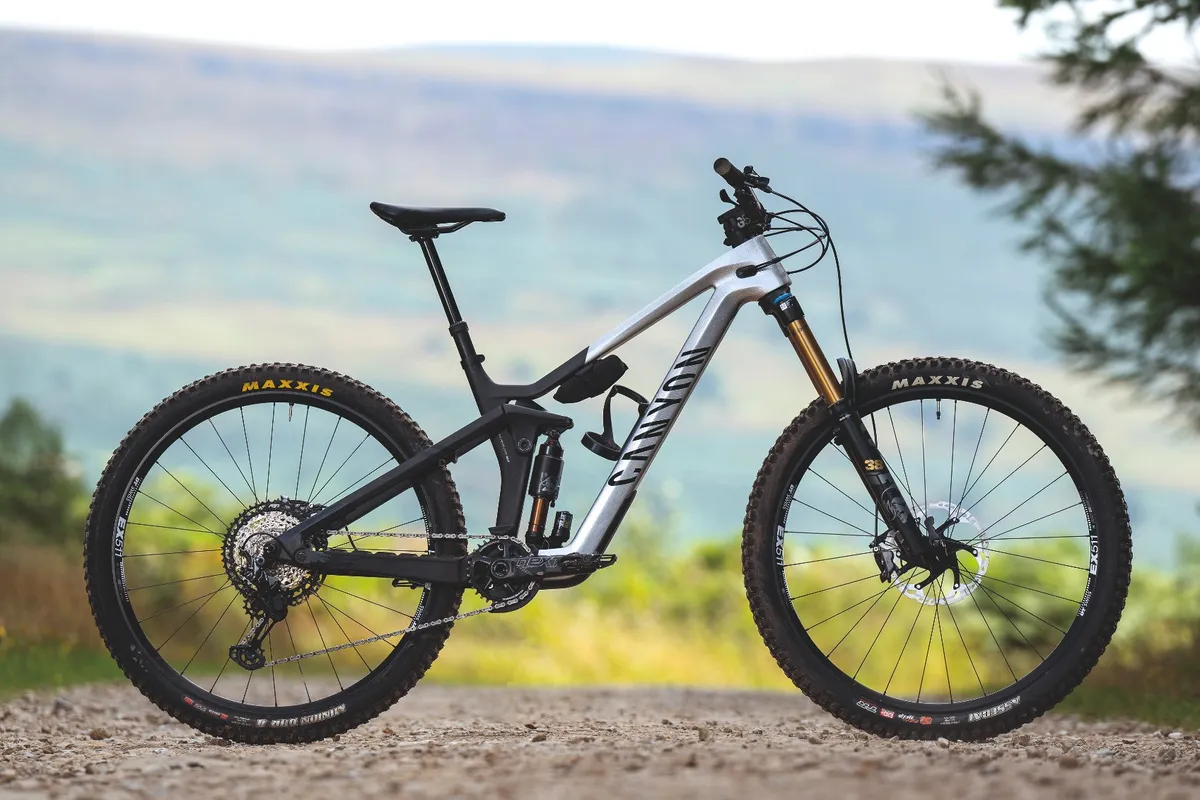
- Price: £5,999 / $7,299 / €6,299 as tested
- Pros: Chassis provides stability at high speeds; race bike feel with high-performance potential
- Cons: Suspension can feel harsh at low speeds
The Strive CFR is Canyon's enduro race bike, rolling on 29in wheels and offering 170mm of suspension travel.
Being direct to the consumer, the Strive CFR is well-specced compared to its competition, with Kashima-coated Fox suspension, Shimano XTR drivetrain and brakes paired with a Race Face Next RS crankset.
The Shapeshifter system allows for better on-the-fly adjustment of the bike's geometry and presents a marked improvement on the previous model.
High speeds are rewarded with impressive suspension kinematics, but when cruising at lower speed, the frame can feel rather harsh.
Cotic RocketMAX Gen4 Mullet Silver
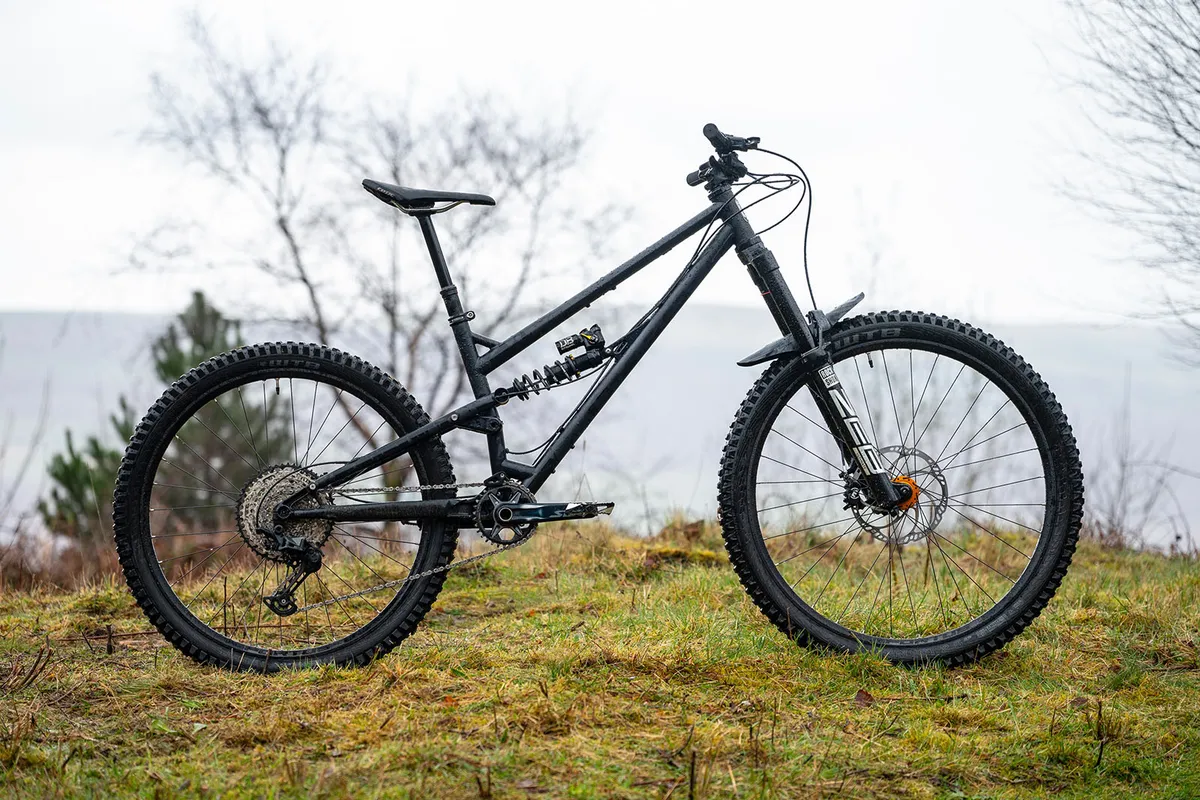
- Price: £4,949 as tested
- Pros: Stable and confident through turns; carries speed well
- Cons: Not as forgiving as other bikes
Cotic's RocketMAX carries speed well when pointed downhill, and handles rough corners with ease –without feeling over-gunned.
The bike's composure is faultless, though our test bike generated quite a lot of noise on bumpy descents.
Cotic offers a host of customisable spec, with our test bike featuring a RockShox ZEB Ultimate fork and a Cane Creek Double Barrel Kitsuma coil shock.
It's not the best climber, but it doesn't feel as though it's needlessly rinsing your energy.
YT Capra 29 Core 4
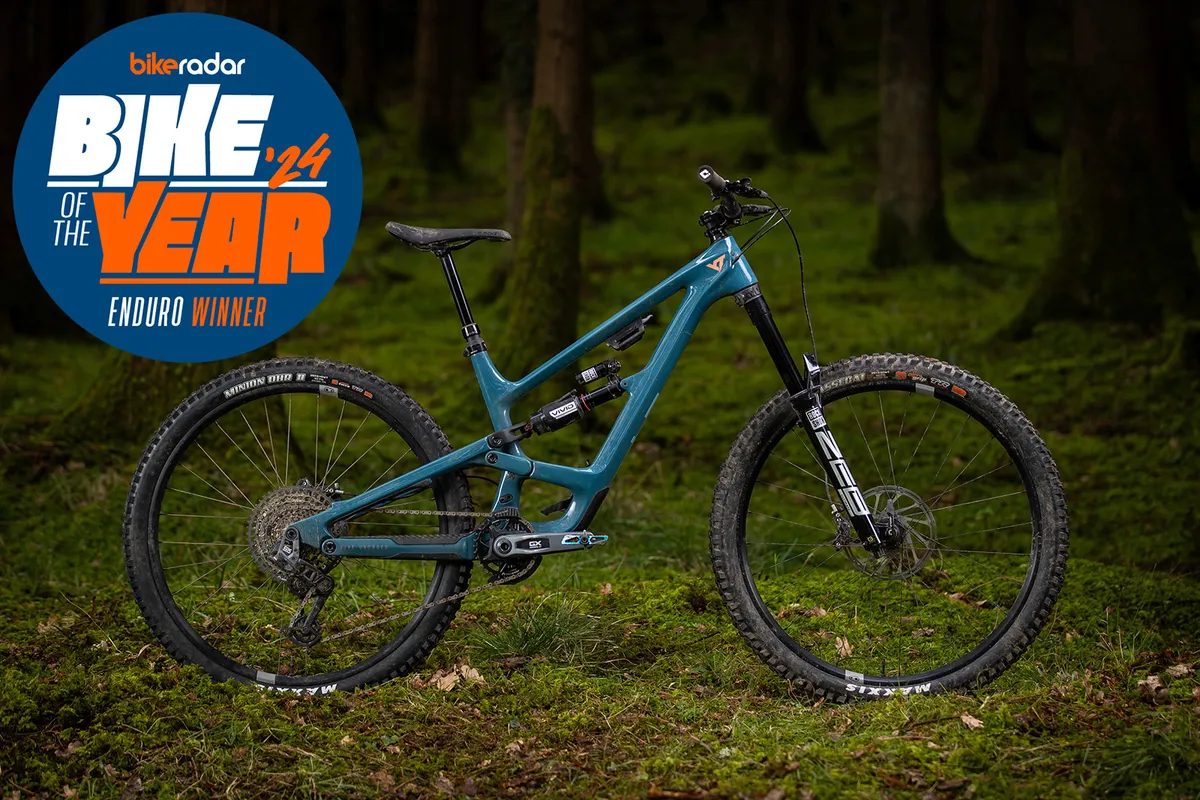
- £4,999 / $5,499 / €4,999 as tested
- Pros: Great spec for the money; impressive on range of trail types; confident at speed
- Cons: Shock tune could be lighter for smaller riders; stem won't be for everyone
YT's Capra Core 4 took the title of our Enduro Bike of the Year 2024 thanks to its impressive value and all-round riding characteristics.
The bike comes with a RockShox Zeb Ultimate fork and a Vivid Ultimate rear shock, which give it an unshakable feel on rough terrain.
SRAM's GX Eagle AXS Transmission also features, making shifting problem-free in a variety of circumstances.
The Capra feels at home ploughing down enduro and downhill trails, but also holds it own on mellower inclines by remaining playful and poppy.
Best electric mountain bikes
The best electric mountain bikes make climbs disappear before disguising their weight on the way back down. 'Full-fat' and 'SL' bikes divide the discipline, with the latter usually having a smaller battery and motor to reduce weight.
Canyon Strive:ON CFR

- £6,699 as tested
- Pros: Excellent power and motor feel; impressive battery life; good value and spec; great suspension platform
- Cons: Shimano drivetrain
Canyon's Strive:ON CFR was our full-power eMTB of the Year 2024, impressing our testers with its impressive riding characteristics, motor and battery life.
The bike sits in the middle of the Strive:ON range and poses good value considering the performance on offer.
With plenty of confidence, the bike feels right at home on gnarly enduro tracks, with plenty of scope for whatever lays on the trail below.
A comfortable climbing position and powerful motor make technical climbing possible, and the battery life is very competitive.
Focus JAM2 SL 9.9
SQUIRREL_TEXT_13140202

- £7,499 / €8,499 / AU$14,499 as tested
- Pros: Impeccable performance; powerful and frugal motor
- Cons: Stock tyres are inadequate; Fazua ring controller feels cheap
The Focus JAM2 SL 9.9 is a lightweight electric mountain bike that uses Fazua's Ride 60 motor, which provides it with 60Nm of torque connected to a 430Wh battery.
Flip chips in the linkage enable you to set the bike up longer, lower and slacker should you wish to make it more aggressive, which helps it span the trail and enduro categories.
The JAM2 SL 9.9 is seriously fun on a variety of trails, and the motor is seemingly frugal, with power consumption lasting for many laps.
The only letdown from the spec was the lightweight tyres, though this is easily corrected.
SQUIRREL_13140202
Orbea Rise LT M-Team
SQUIRREL_TEXT_13182182

- £8,943 as tested
- Pros: Sorted geometry; great suspension; rewards hard riding
- Cons: Could be more forgiving; mid-sized impacts aren't absorbed the best
The Rise LT M-Team has a direct chassis, giving it a sporty trail-bike feel and hiding its weight well.
It excels when ridden hard, with proactive inputs resulting in great capability on technical terrain, and the sorted suspension reacts well to big hits.
While the bike rewards hard riding, where proactive inputs make it extremely capable, we found the suspension wasn't the most forgiving – with mid-sized impacts not being smoothed out that well.
Despite this, the bike feels agile and, with considered line choice, excels on the descents.
Shimano's STEPS EP801 motor and XT groupset feature, with the motor turning out 85Nm of torque, connected to a 420Wh battery.
SQUIRREL_13182182
Specialized S-Works Turbo Levo SL II
SQUIRREL_TEXT_13083854

- £13,000 as tested
- Pros: Incredibly wide performance band; adaptable geometry
- Cons: Inadequate rear tyre casing; cost
Specialized's latest S-Works Turbo Levo SL uses the 'semi-skimmed' Turbo SL 1.2 motor, which pumps out 50Nm of torque and 320W of power.
The bike feels at home on all types of terrain, from shallow gradient flow lines to steep, rough tech.
Adjustable geometry enables you to run the bike with a 'mullet' setup, with the smaller wheel adding extra agility.
A high-end spec list featuring Fox Factory suspension and SRAM's XX Eagle Transmission, makes the bike a masterpiece at pace, though this comes at a cost.
SQUIRREL_13083854
Whyte ELyte 150 Works
SQUIRREL_TEXT_13120628

- £9,999 as tested
- Pros: Balanced geometry; composed suspension system; excellent spec; relatively light
- Cons: Motor cadence sweet spot; rear tyre could be beefier
Whyte's ELyte took home our Lightweight Ebike of the Year 2024 award, impressing us with its all-round trail capability, smooth suspension system and light weight.
The bike is fitted with Bosch's Performance Line SX motor, which provides plenty of oomph if kept within a high cadence range.
Unfortunately, the 36t chainring made this difficult on steep sections, but this can be swapped out relatively inexpensively.
We were impressed by the ELyte's natural feeling on descents, although we needed to work harder than on some other bikes to get the most out of it.
SQUIRREL_13120628
Best hardtail mountain bikes
The best hardtail mountain bikes will provide excellent efficiency without transferring every bump on the trail through the pedals.
Lapierre Prorace CF 9.9
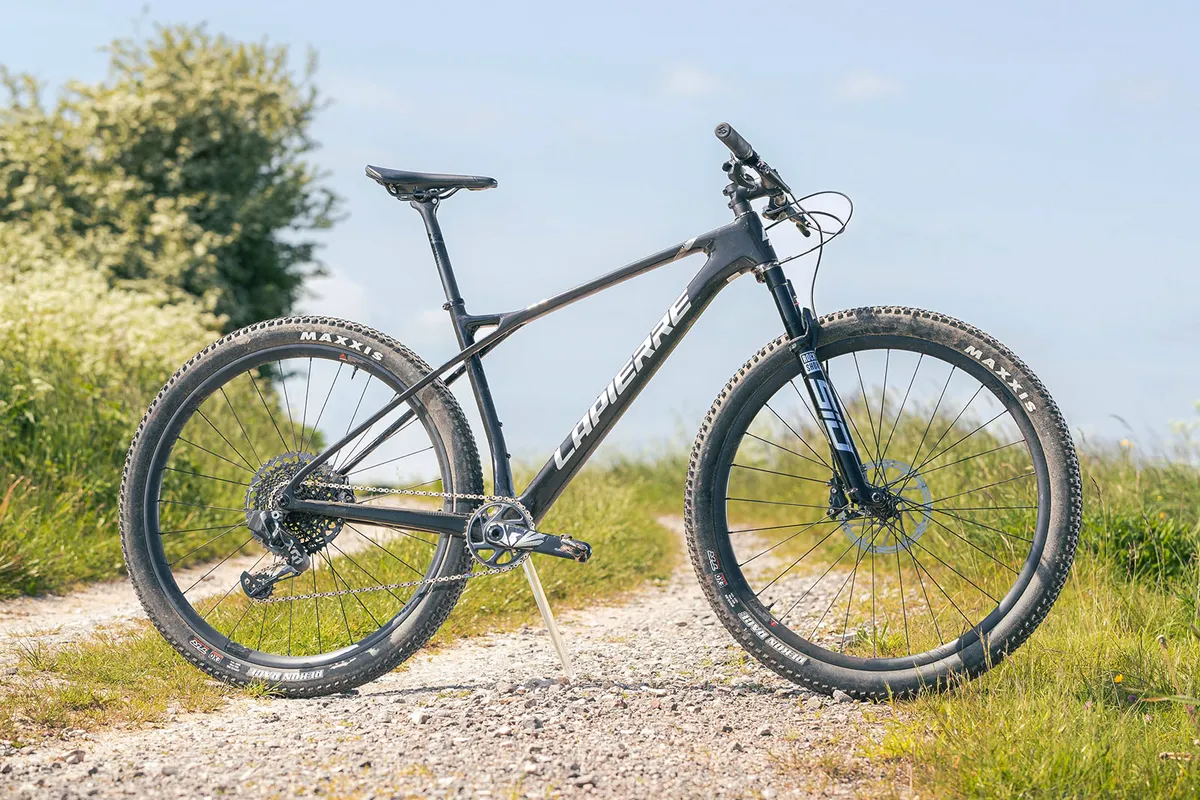
- £5,999 / €6,799 as tested
- Pros: Good value for the money; great all-round capability
- Cons: Press-fit bottom bracket may be a pain for home mechanics
The Lapierre Prorace CF 9.9 is designed for cross-country racing and uses a carbon fibre frame with in-built compliance.
A triple-triangle design is used to give lateral flex to the bike's rear end, which adds traction on technical climbs and damps trail noise well.
The geometry makes the bike agile and engaging on the trail, with the Prorace inspiring confidence on descents thanks to calm and predictable handling.
While it's pricey, SRAM's X01 AXS groupset, the RockShox SID SL Ultimate fork and Lapierre's own XC SL carbon wheelset make up a decent spec for the money.
Fairlight Holt XT

- £3,709 as tested
- Pros: Smooth ride quality; great comfort; plenty of mounts; custom options
- Cons: Not the most capable descender
The Holt is designed for covering long distances, with great pedalling efficiency, comfort and plenty of mounts to carry bikepacking essentials.
It doesn't perform the best on technical trails because the steep head angle makes it feel awkward on steeper terrain.
Our tester enjoyed the ride feel, finding it smoothed out rough ground and remained pingy in the corners
Specialized Rockhopper Elite 29
SQUIRREL_TEXT_13154702

- £949 / $1,150 / €975 / AU$1,300 as tested
- Pros: Fast-rolling and quick up the hills; lightweight and well specced
- Cons: Short fork travel is limiting
The Rockhopper Elite 29 has a solid spec choice that makes it fun on not so technical trails
29in wheels help roll over the majority of trail imperfections and the RockShox Judy Solo Air fork provides good support on the descents.
Its short travel, which ranges from 80mm to 100mm depending on size, makes for an engaging ride, though it requires some skill to navigate technical sections of trail.
SQUIRREL_13154702
Best downhill mountain bikes
The best downhill bikes will eat up the lumpiest terrain on offer, with the longest travel of any discipline and geometry that is focused solely on descending.
Giant Glory Advanced
SQUIRREL_TEXT_13093202
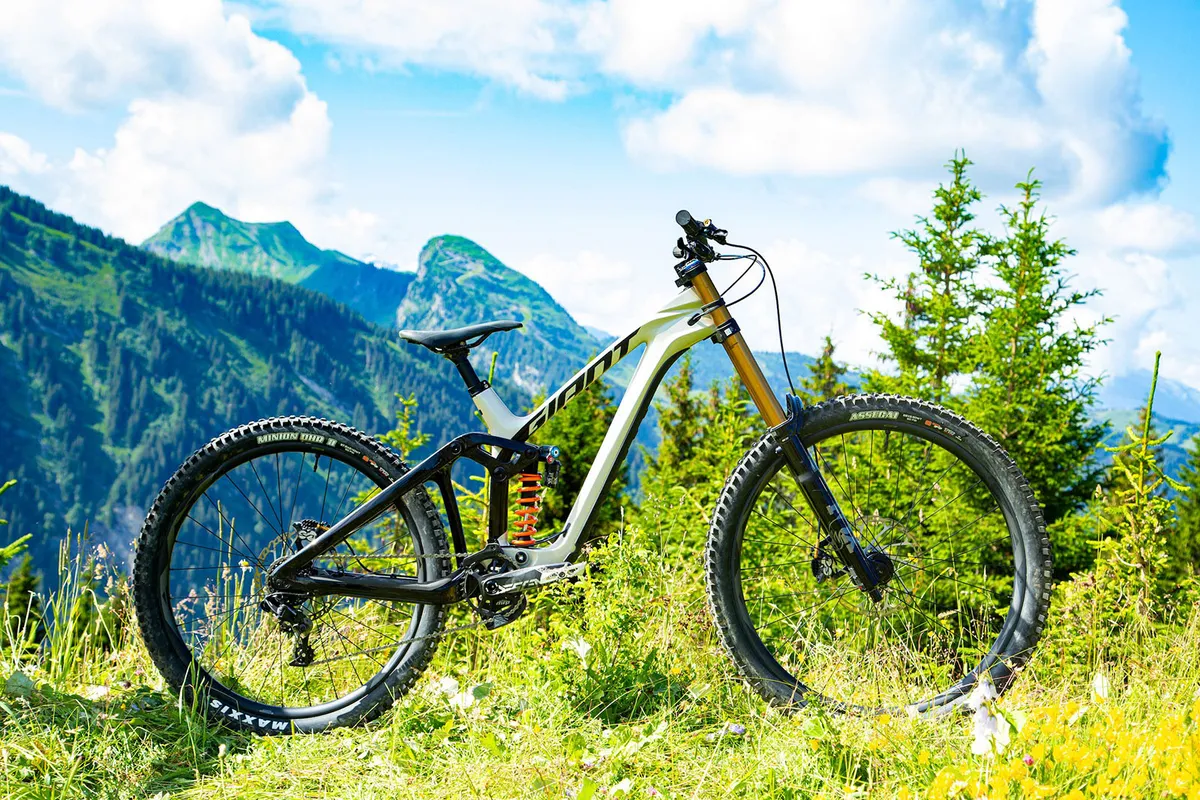
- £7,499 / $8,000 / €7,999 / AU$11,499 as tested
- Pros: Plush travel with plenty of support; high levels of adjustability; great shock tune
- Cons: Rims dent easily; high-speed rebound adjuster difficult to reach
Giant's Glory lives up to its legacy, with a capable and sturdy ride feel that eggs you on down the choppiest of descents.
This Glory Advanced comes with a 203mm Fox Factory 40 fork up front and a DHX2 Factory shock controlling 200mm of travel, which soaks up big hits well.
Adjustable geometry in the frame enables you to experiment with different setups to dial in the bike.
The Giant AM30 rims are the Achilles heel of this bike and were quick to dent through rough terrain.
Giant's Glory performs well when faced with a variety of trails and conditions, maintaining its composure throughout.
SQUIRREL_13093202
Propain Rage 3 CF Mix Highend
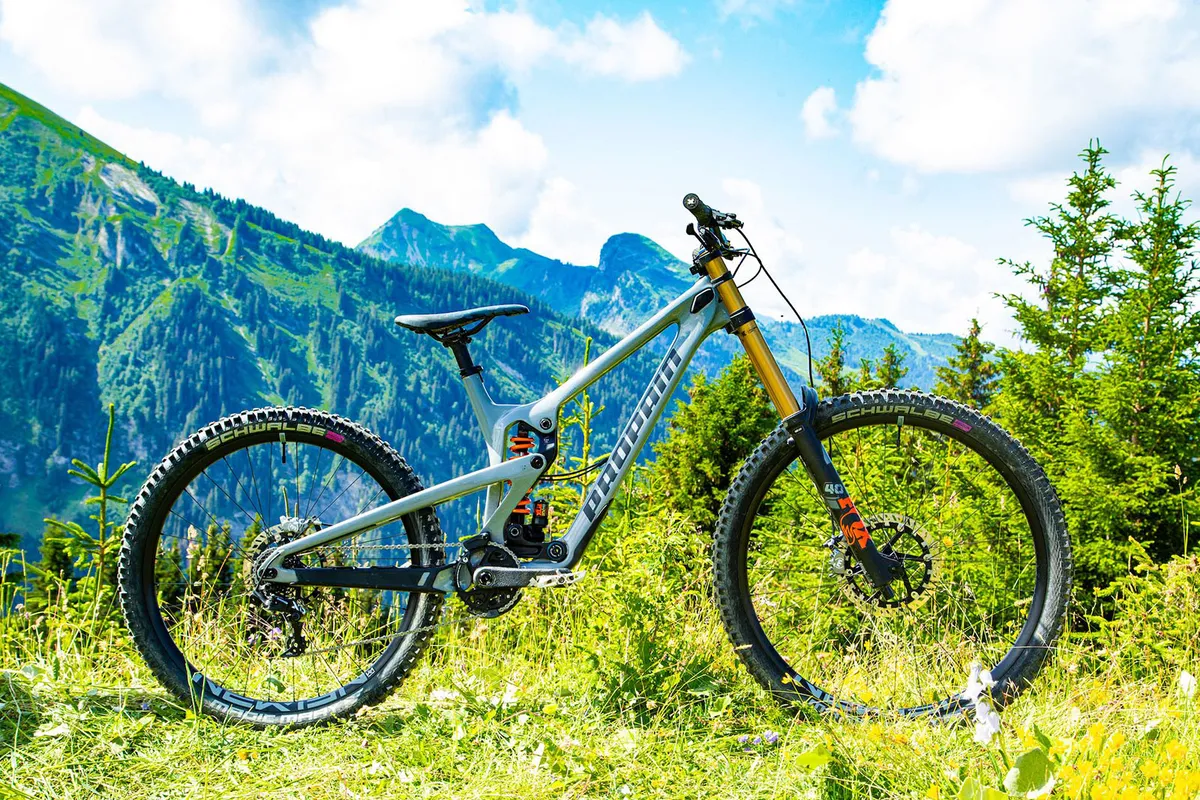
- £6,519 / €6,389 as tested
- Pros: Handles steep tech and jumps with ease; 215mm of travel is very forgiving; pedals better than expected
- Cons: Seat tube could be shorter; saddle a little chunky for our tester's preference
The Rage 3 offers top-end performance at a reasonable price, with a 200mm Fox 40 Factory fork featuring up-front and a Float DHX2 Factory shock mounted in the frame.
The bike has a playful character and provides high levels of performance whatever the gradient, with the 215mm of rear-wheel travel sucking up big hits and remaining supportive down the trail.
On the roughest terrain, the bike lacks the same composure as other bikes we've tested.
Saracen Myst Pro
SQUIRREL_TEXT_13156853

- £3,600 as tested
- Pros: Impressive geometry; balanced and composed ride feel; capable suspension on all terrain
- Cons: A cartridge upgrade in the Boxxer wouldn't go amiss
The Saracen Myst Pro is an out-and-out race machine, tested and developed on the DH World Cup circuit.
Saracen’s Ride Tuned Link suspension delivers 211mm of travel. Its smooth yet capable suspension impressed us, tracking well even on the chunkiest sections of trail, while keeping big hits a bay.
Its long reach and chainstay figures make it well-balanced at high speed, remaining calm and composed on everything we threw at it.
At only £3,600, it offers impressive value for money too.
SQUIRREL_13156853
Best budget mountain bikes
The best budget mountain bikes will get you out on the trails without breaking the bank, and offer a solid platform for you to develop your skills on.
Rockrider AM 100
SQUIRREL_TEXT_13116701

- £1,000 as tested
- Pros: Up-to-date geometry; great warranty; responsive ride feel
- Cons: A bigger dropper post would give more agility
The Rockrider AM 100 is very capable thanks to a modern geometry that puts you in a confident riding position.
For the price, it has a considered spec list and a stylish frame designed to deal with the horrors of winter thanks to length cable outers routing externally.
The bike covers ground well and is gives you confidence to push harder on descents.
We did find the brakes lacked a little punch, but they were ample for the majority of trail centre shoots
Up-to-date standards mean these can easily be upgraded should you want more powerful brakes.
SQUIRREL_13116701
Voodoo Bizango Pro
SQUIRREL_TEXT_13086298
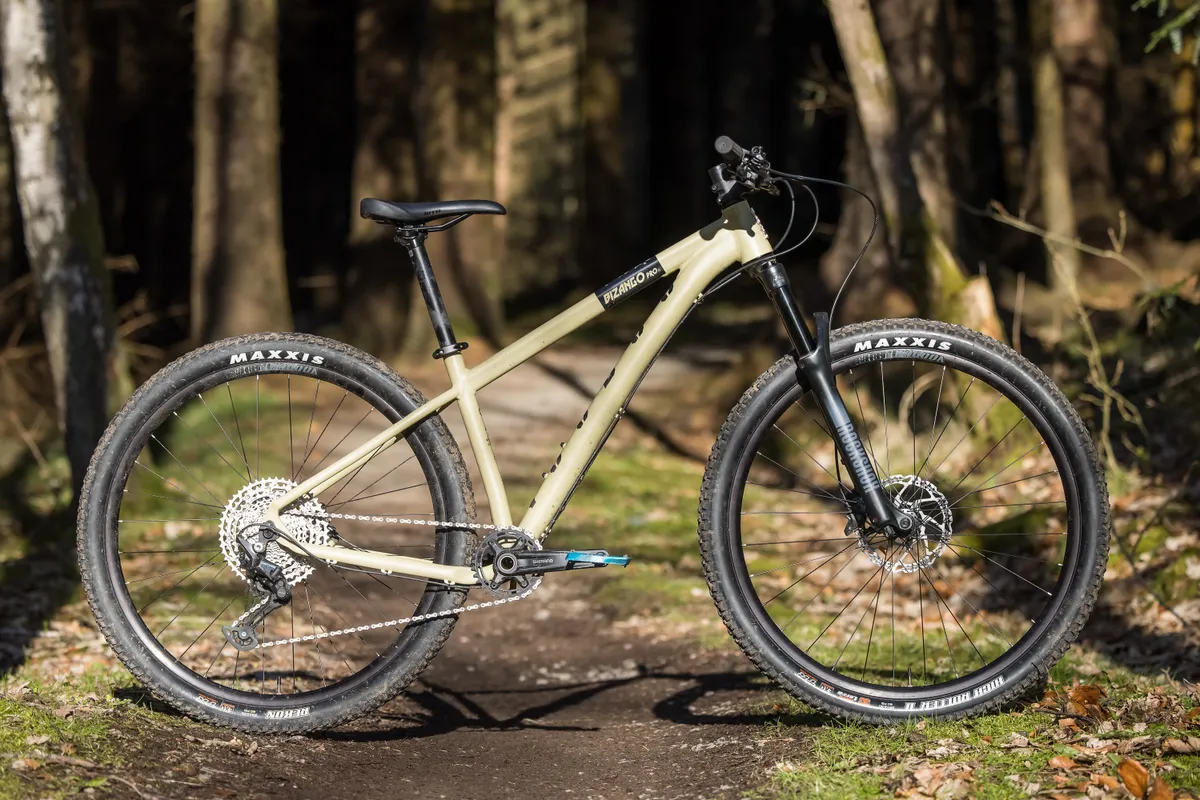
- £950 / $1,258 as tested
- Pros: High-quality spec for the price; upgrade potential
- Cons: High stack height
The Bizango Pro offers a high performance level at a very reasonable price.
A proper trail spec features, with a RockShox FS-35 Gold 130mm fork, 12-speed Shimano Deore and Maxxis tyres helping to get the most out of the frame.
The bike is very confidence-inspiring, feeling stable downhill and especially so when railing turns.
This led us to push the bike further than trail-centre blues and reds, and into more technically rated trails.
Tolerances between the seat tube and seatpost are quite large, which leads to the saddle dropping on occasion, though this was solved by the application of some carbon assembly paste.
SQUIRREL_13086298
Calibre Rake 29
SQUIRREL_TEXT_13116713

- £700 (£550 with GO Outdoors membership card) as tested
- Pros: Impressive value for money; playful handling
- Cons: Lack of thru-axles limits wheel upgrades
The Calibre Rake 29 offers great value for money, featuring spec that wouldn't be out of place on bikes twice the price.
A 100mm RockShox FS-Judy TK takes the vibrations out of rough trails, although there's some flex in the fork on hard compressions, making steering a little inaccurate when pushed hard.
The Clarks M2 hydraulic disc brakes give confident stopping power that enables you to tackle trail-centre descents with speed.
While the frame was quite stiff, the WTB Trail Boss tyres provided plenty of comfort and gave enough grip to comfortably push the bike.
SQUIRREL_13116713
Carrera Titan X
SQUIRREL_TEXT_13079644
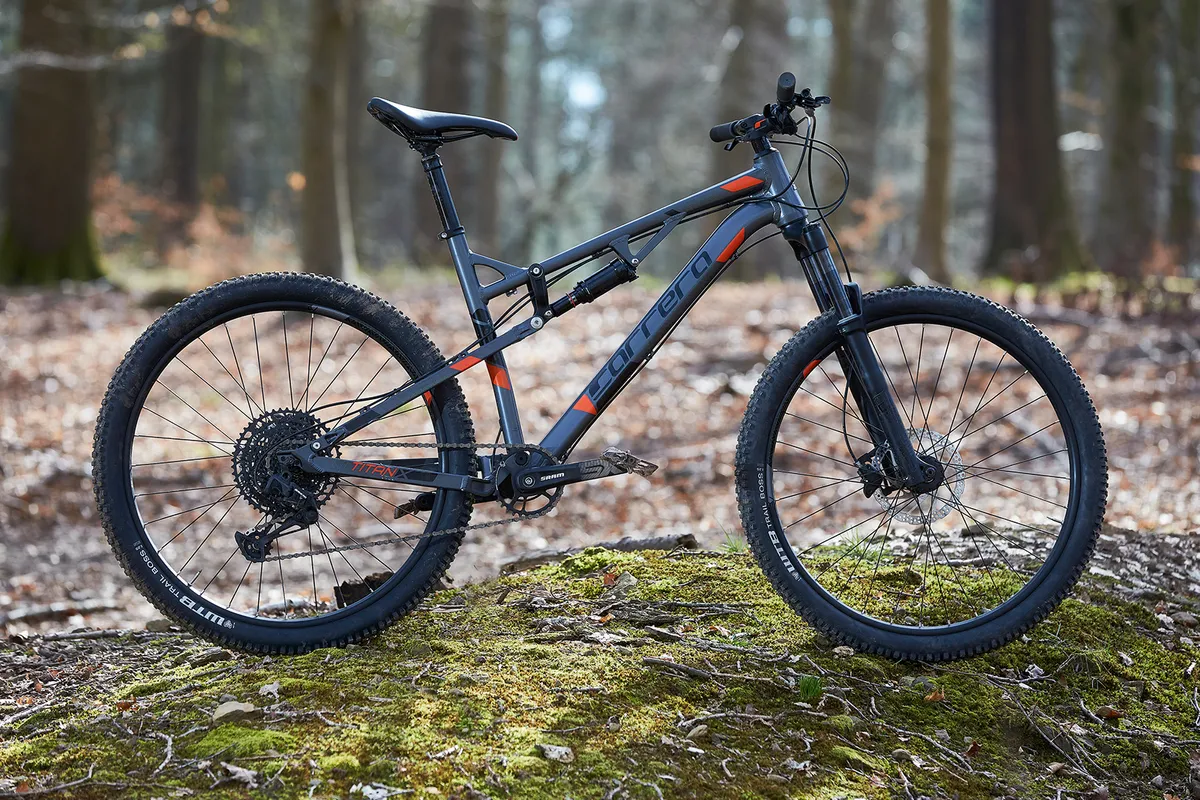
- £850 as tested
- Pros: Better equipped than virtually anything else at this price; rear suspension is good for the money
- Cons: Three-size range doesn’t work for taller riders
The Titan X offers serious value for money, with full-suspension and a SRAM SX 12-speed drivetrain.
Its geometry might not be as progressive as pricier options, but it's by no means a throwback and it impresses on both climbs and descents.
The dropper post offers big performance gains too, and while the handling over technical terrain isn't the best, there's no getting past how good the kit is on this bike for the price.
Our only major concern is that the three-size range will limit smaller and taller riders.
SQUIRREL_13079644
How we test mountain bikes
We’ve been testing mountain bikes for well over a decade, and have tracked major developments in mountain bike tech, from the widespread adoption of the dropper post through to electronic suspension.
We’ve tested all the major mountain bikes since our inception in 2007, from cross-country bikes to downhill bikes and budget rides to pro-level superbikes.
Working with our colleagues at MBUK magazine, our bike reviews are always editorially independent – with no exceptions. Our reviewers comprehensively test each bike, always reflecting on performance, value and the wider market when delivering their verdict.
Why you can trust BikeRadar
BikeRadar has been an authority on bikes and cycling tech since its inception in 2007, delivering the world’s best riding advice.
We have experts testing all types of bikes, parts, clothing and accessories, from road, mountain and gravel bikes to commuting, bikepacking and electric bikes.
Our reviews are always editorially independent – with no exceptions. Our reviewers comprehensively test all products in the real world, always reflecting on performance, value and the wider market when delivering their verdicts and review ratings.
We have more than 15,000 product reviews available at your fingertips, as well as expert buying, maintenance, training, skills, health and fitness advice.
Our annual Bike of the Year test is an industry benchmark and the BikeRadar team consists of some of the most experienced riders and testers in the business.
Buyer's guide to mountain bikes

Choosing a new mountain bike to buy can be daunting. The sheer variety of mountain bike types, not to mention the bewildering array of technology and terminology, may feel overwhelming.
Technology evolves every year, new mountain bike standards emerge and old ones swiftly become outdated. An ever-growing dictionary of jargon means the mountain bike market can be a confusing place, even for seasoned riders.
Highly specialised bikes sit side-by-side with machines that claim to excel at everything. And they’re all spread over such a vast price range that it can be hard to know where to start.
This guide sets out all the factors you should consider when looking for a new ride.
Where do you want to ride?
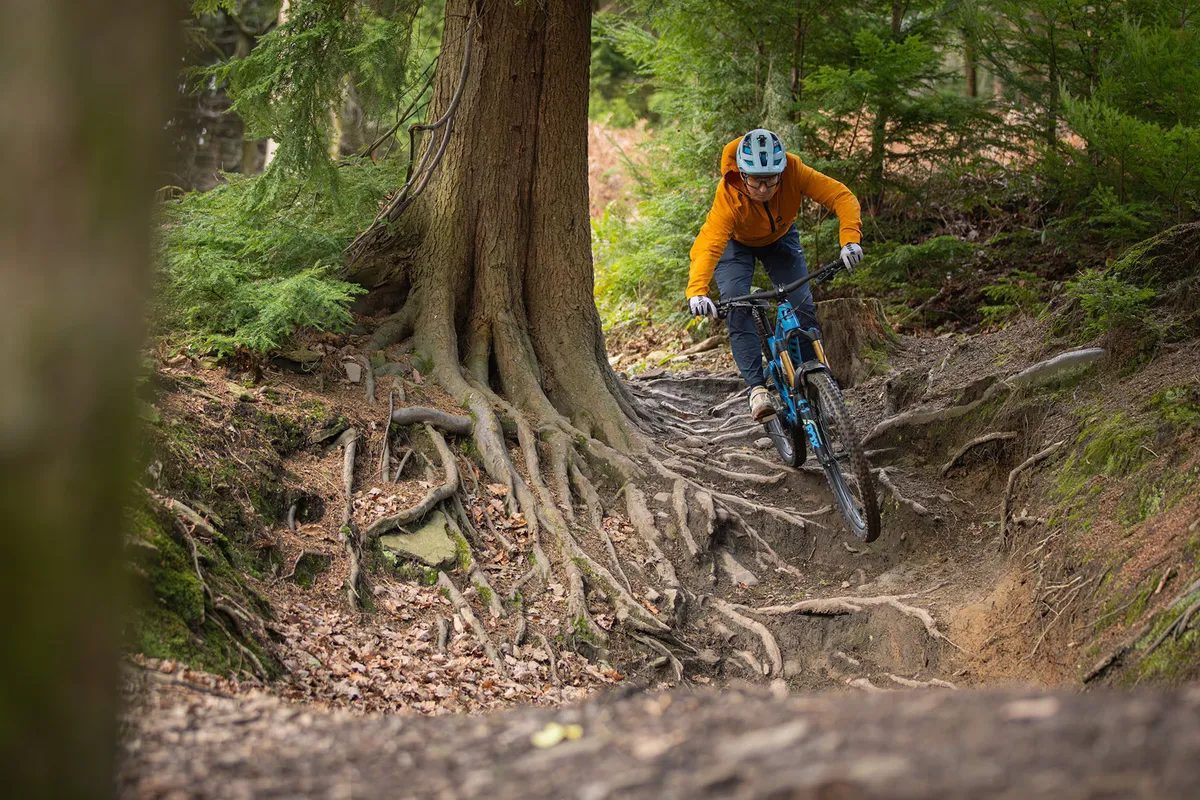
It’s important to establish early on what sort of trails you intend to ride and on what terrain you want your bike to excel.
This will help you decide what category of bike you need, from short-travel, lightweight cross-country rigs to robust, chunky downhill race bikes.
The different types of mountain bike
There are four main categories of mountain bikes, with each having its own intended discipline.
Cross-country bikes

Cross-country bikes usually feature 60-120mm of suspension travel and are designed for smooth and fast-flowing trails, as well as competing on the race circuit.
These bikes tend to feature svelte framesets that reduce weight, making them excel at climbing and rapid acceleration.
Downcountry has emerged as a subdiscipline that sits at the more aggressive end of cross-country, with downcountry bikes featuring beefier components to tackle heavier trail use.
Trail bikes
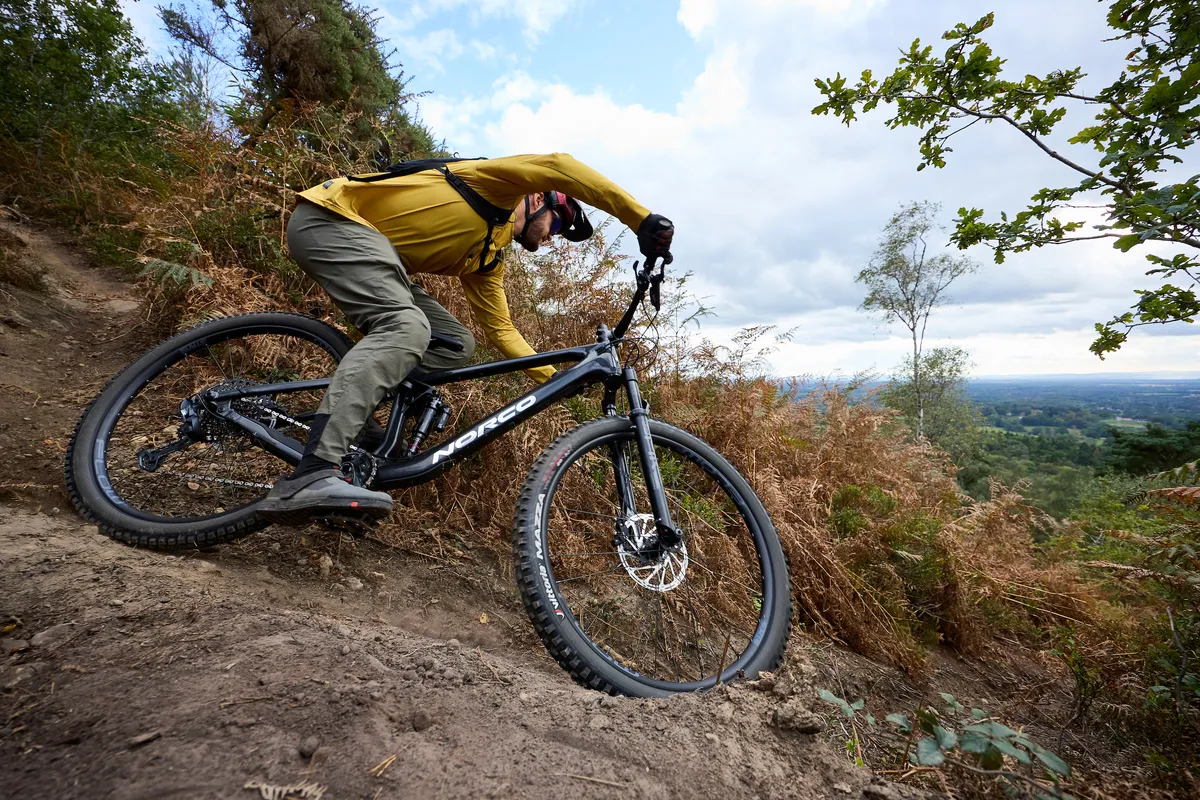
Trail bikes are what the majority of people ride, with suspension travel ranging from 120-160mm.
These bikes are designed to get you up to the top of a trail with relative efficiency, while providing good capability on the way back down.
They aren't quite as hard-hitting as enduro bikes, but this trade-off is often made in the interest of weight savings.
Enduro bikes
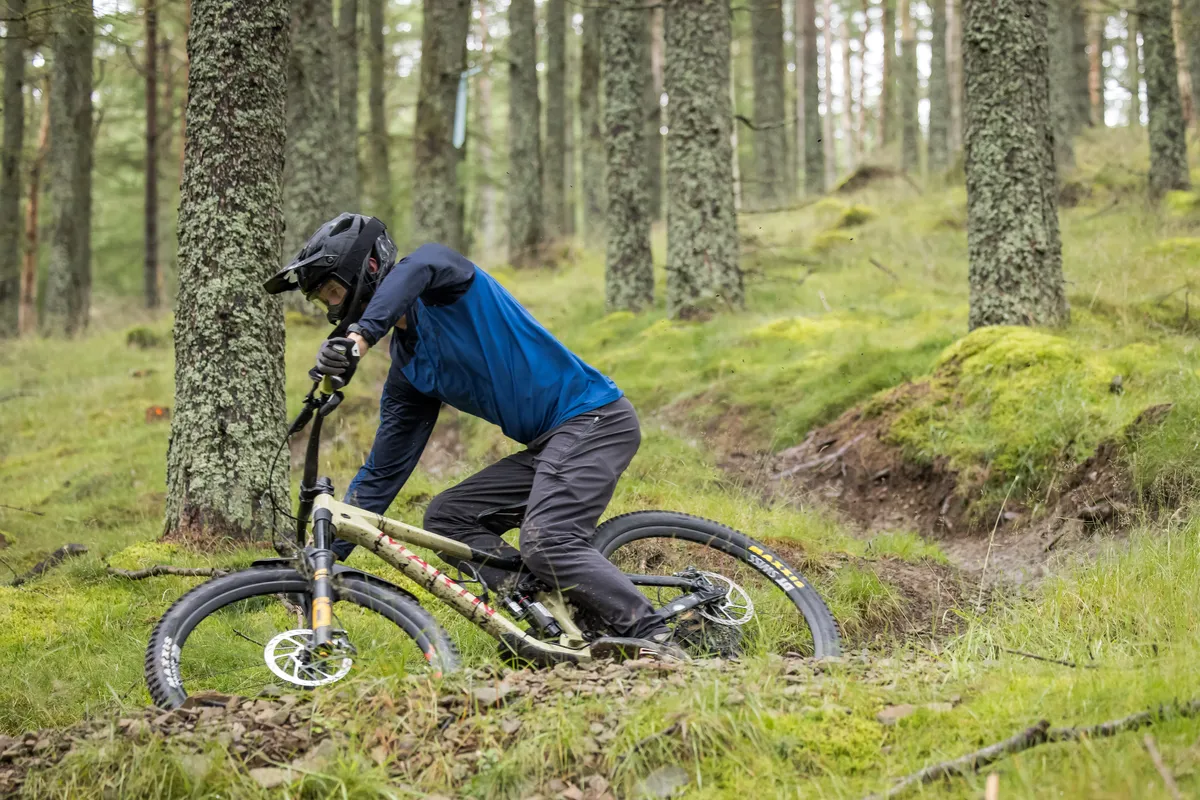
Enduro bikes provide downhill bike capability, while enabling you to winch yourself to the top of the trail.
With travel that can range from 160mm to 190mm, these bikes eat up descents, providing plenty of gravity-fuelled fun.
Due to their added strength and capability, they aren't as efficient as trail bikes, though low gearing should get you up the same climbs.
Downhill bikes

Downhill bikes are focused solely on descending, with travel that is usually 200mm or more.
These bikes are often used at bike parks because their gearing means it's near-impossible to ride back to the top of the trail, making a chairlift or ca lift necessary.
Thanks to their speciality, there is no comprise in the geometry for climbing ability, making them the fastest and most stable bikes to descend on.
What to look for in a mountain bike
Suspension

Less suspension travel usually means a lighter, faster bike uphill.
More travel equals better downhill capability. If you’re new to the sport and want to try a bit of everything, a mid-travel trail bike is the best all-rounder.
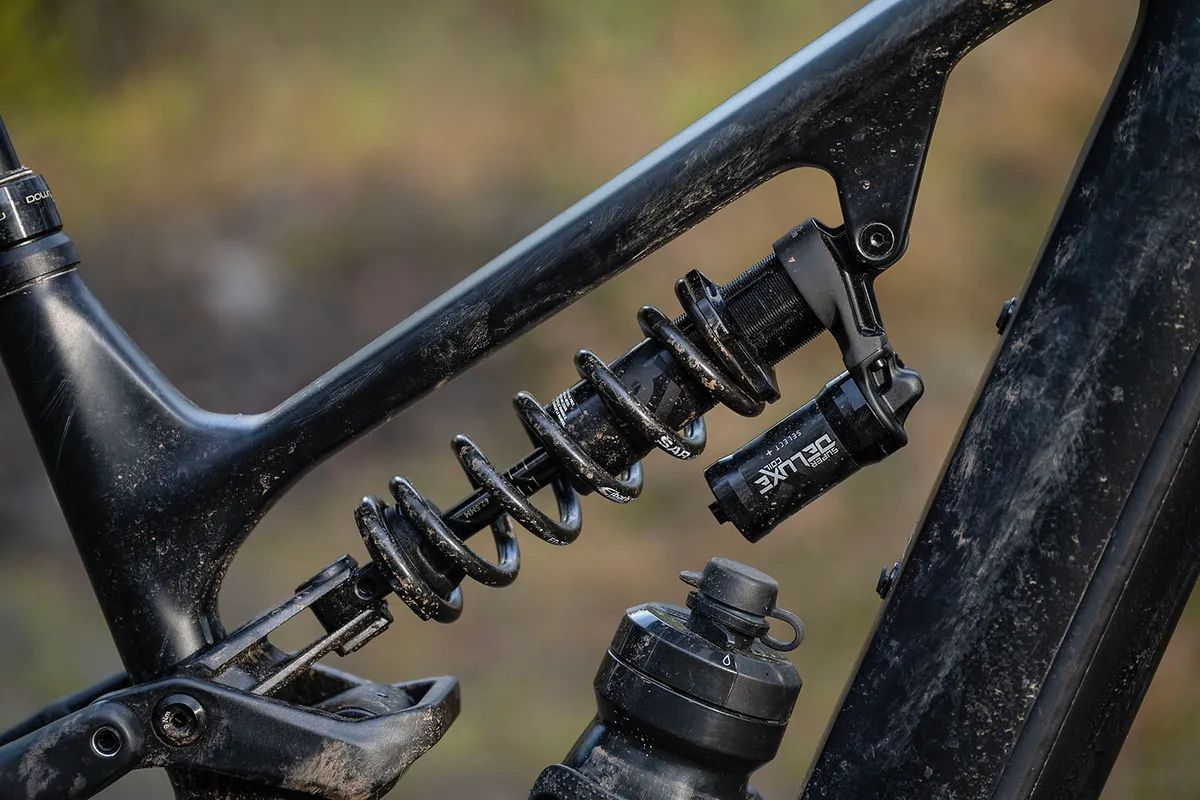
Mountain bike suspension usually comes in two flavours, coil and air, with the former offering greater sensitivity at the cost of extra weight and the latter providing more adjustability.
We have answered the question of how much suspension travel you need elsewhere, but if you're just getting started it's best to go for a mid-travel bike to suss out the riding you prefer.
Geometry
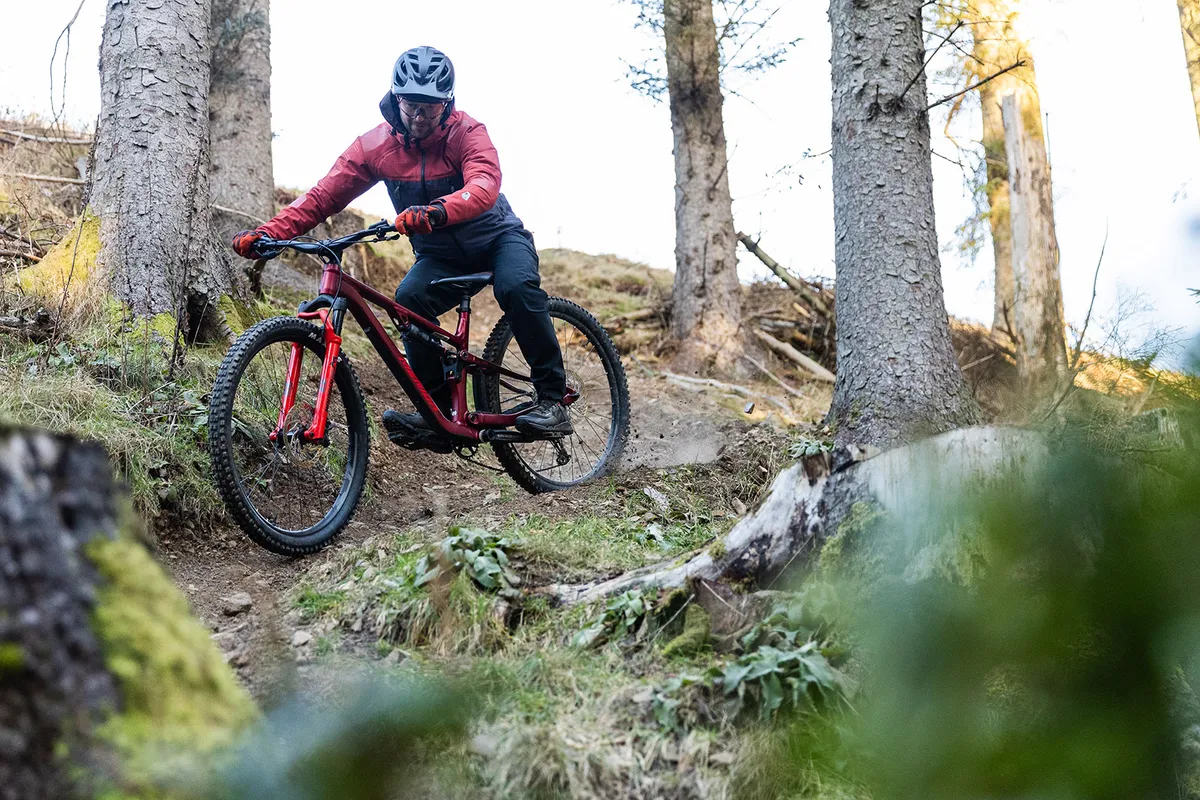
The geometry of a mountain bike is largely dictated by which discipline it’s made for, whether that’s a fast and responsive cross-country bike, a slack downhill race rig for gnarly trails or anything in between.
For the sake of simplicity, we won’t go into the specifics of geometry here – it's another complex area of mountain bike tech.
However, you can check out our ultimate guide to bike geometry if you want to learn more.
Wheel size
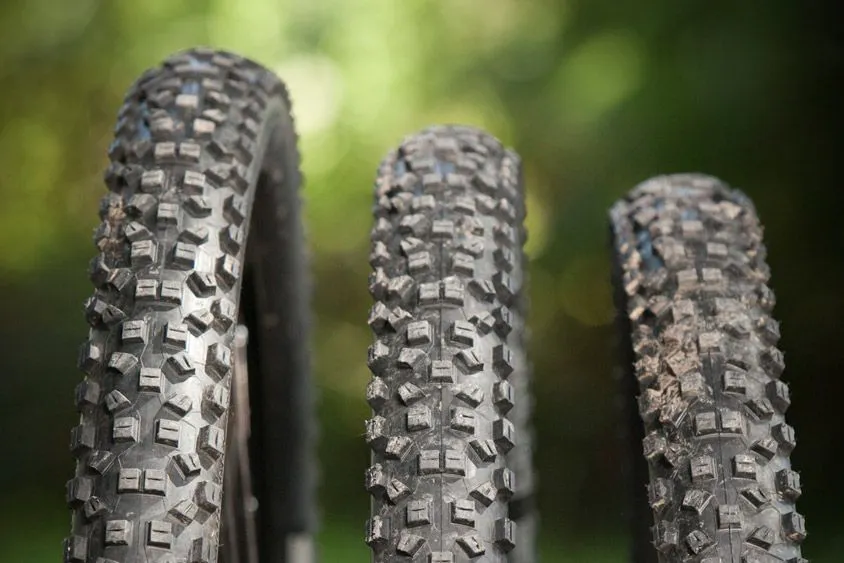
For a long time, 26in mountain bike wheels were the standard, but with the exception of dirt-jump and slopestyle bikes, they’ve been phased out in favour of larger, faster-rolling hoops.
Any new adult bike will likely come with either 27.5in (also known as 650b) or 29in-diameter wheels.
29er wheels have the advantages of carrying momentum better, rolling over obstacles more easily and providing more traction (due to the longer contact patch of their tyres).
The disadvantages are that the bigger wheels accelerate slower, take more effort to slow down and are harder to initiate a turn with.
This isn’t a problem in most scenarios, but if you have quite a dynamic riding style or like to ride trails that are tight, twisting and steep, 650b can be preferable.
Mullet bikes use different-sized wheels at either end of the bike, most commonly a 29in front wheel for speed and rolling over obstacles and a 27.5in back wheel for sharp handling at the rear.
Frame material
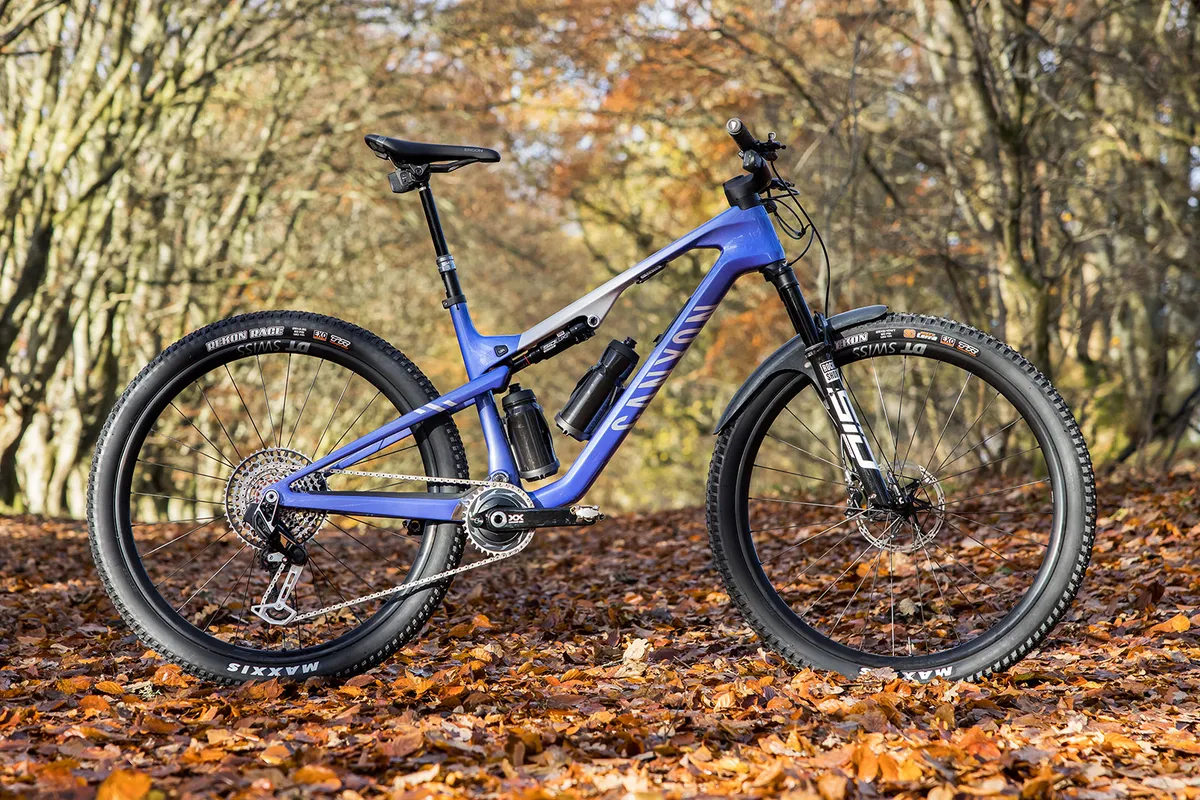
You have four main options when it comes to frame material for bikes: aluminium, steel, titanium and carbon fibre.
Aluminium is the most commonly used frame material for mountain bikes because it offers a good balance of strength, weight and cost.
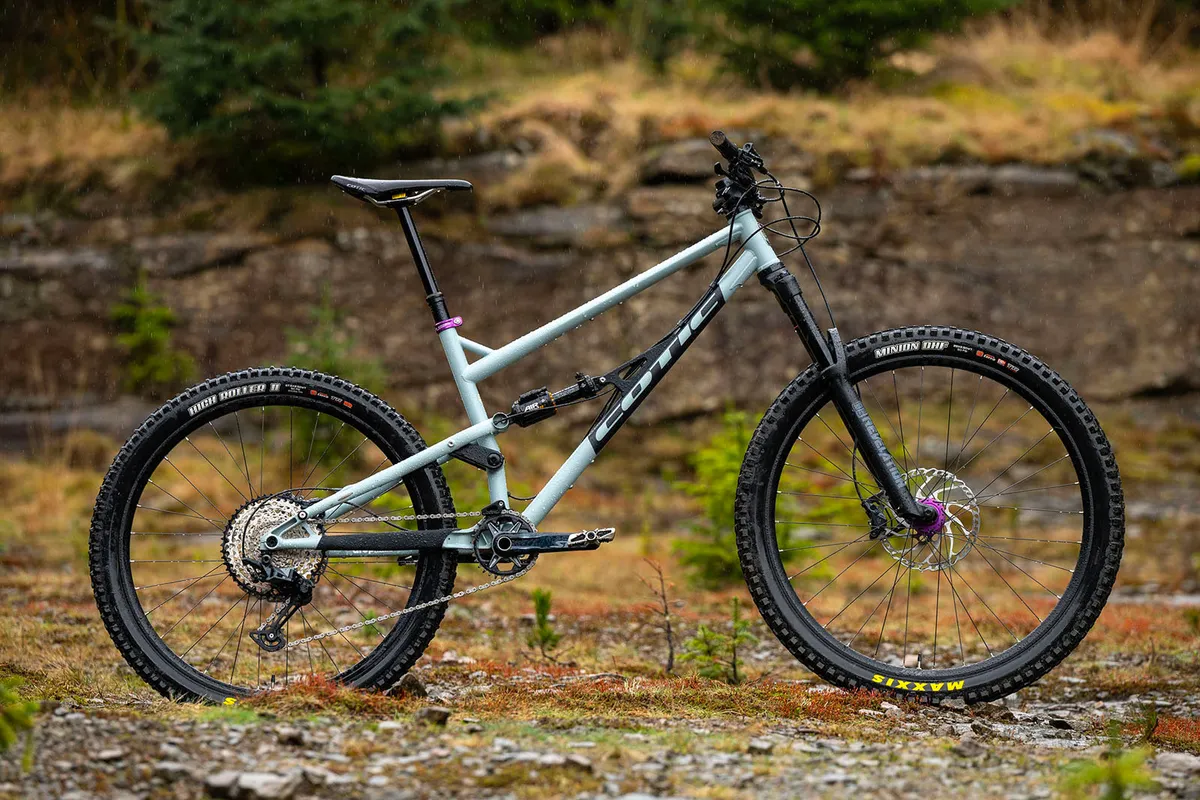
Steel is a popular choice with smaller boutique brands, not only because it’s widely available and easy to work with, but also because the same strength can be achieved with thinner-walled and smaller-diameter tubes, resulting in a desirable amount of bump-absorbing ‘compliance’ (flex). This is particularly applicable to hardtails.
Titanium does the same with less of a weight penalty, but expect to pay upwards of £2,000 for a titanium frame.
Carbon has long been one of the buzzwords used to ‘upsell’ to bike buyers. To some extent, this is justified, because carbon fibre gives designers near-limitless control over frame shapes and ride characteristics, as well as the potential to build an incredibly light and strong chassis. This is important if you're choosing a featherweight XC race bike.
Cheaper carbon frames aren’t necessarily laid up with the same care and attention to detail, though. Also, be aware that at lower price points, brands will often spec cheaper build kits to prevent the complete bike looking too expensive compared to the next (aluminium) model down.
A better-specced aluminium bike will almost always ride better than a carbon frame decked out with cheap kit.
Mountain bike specifications to consider
- Dropper posts: Many mountain bikes now come with dropper posts. These enable you to drop your saddle via a remote on the handlebar so you can more easily move your weight around your bike.
- Wheels: Lightweight mountain bike wheels will make acceleration easier, while heavier ones will tend to fend off rock strikes more easily. Wheels are often something riders look to upgrade on a bike.
- Disc brakes: Most mountain bikes will feature disc brakes, with the better ones using a hydraulic system as opposed to cable-actuated. Two-piston designs are usually enough for trail use, but it's best to look at four-piston models for enduro and downhill.
- Pedals: Many mountain bikes won't be supplied with pedals, so it's best to pick your own. Clipless pedals keep your feet attached to the bike using a locking mechanism, increasing efficiency and guaranteeing foot placement, while flat pedals enable you to easily remove your foot and are good for learning the basic skills.
- Tyres: This is one of the most important parts of the bike, being the only component that should make contact with the ground. Lighter tyres will feel zippier when accelerating, though this usually comes at the cost of puncture protection.
Women's mountain bikes

Some brands offer women's specific mountain bikes, such as Giant's Liv and Scott's Contessa range.
These bikes usually feature geometries and component choices that are designed for the female anatomy and should, in theory, result in a more comfortable ride than on unisex bikes.
Finding the right-size mountain bike
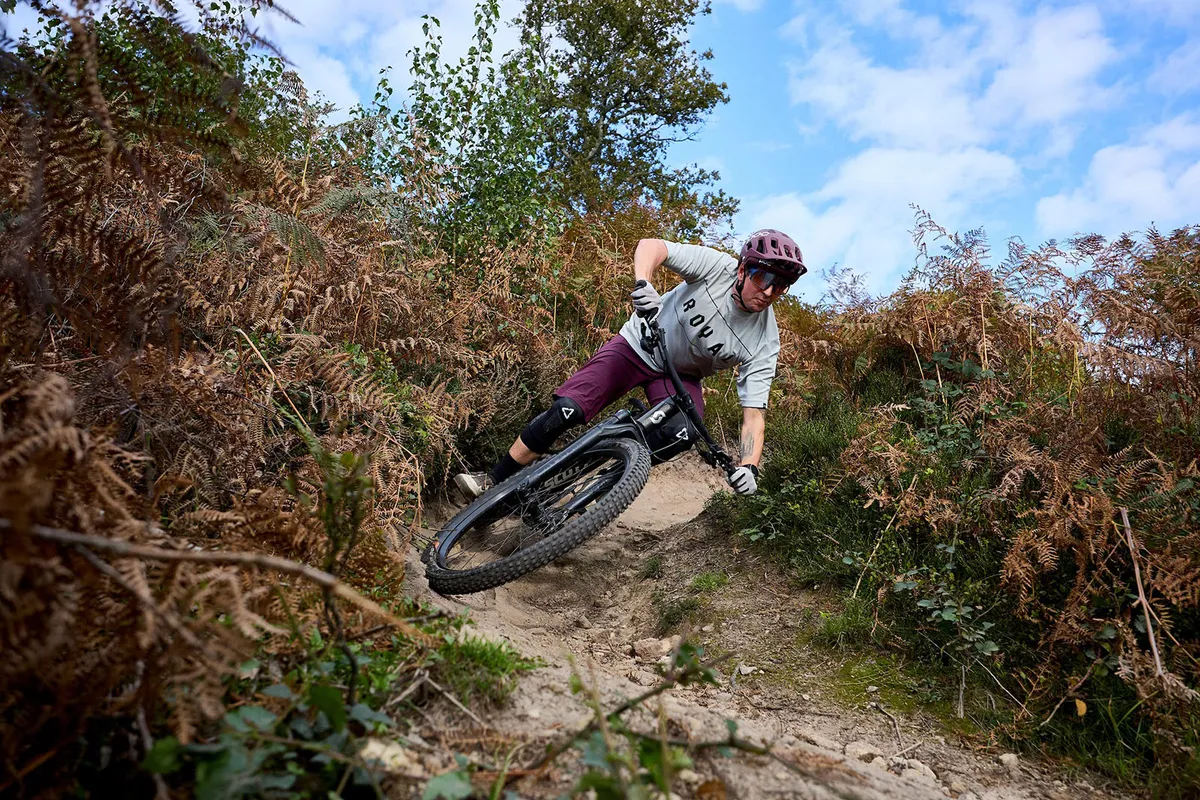
Getting a bike that fits you properly is extremely important. Not only will it ensure you're more comfortable on the bike, but you'll also be able to ride the bike to your maximum potential.
Our guide to mountain bike sizing is a good starting point – but remember, geometry and sizing aren’t consistent between brands, so always make sure to check the measurements. Don’t be tempted to compromise on fit.
If it isn’t quite right for you – the top tube’s a little short or you can’t get the seat low enough, for example – it’ll affect your fun far more than a fancy paintjob and a posh suspension fork. Riding the correct-size bike will also help you position your body on technical terrain.
If this is your first new bike in a while, it might surprise you how much longer they’ve got in recent years. This isn’t because we’ve all suddenly got taller, but because designers have figured out that stretched-out bikes with slacker head angles handle better at speed.
Any initial awkwardness you may feel when trying to manoeuvre a bigger bike around will soon disappear (assuming it’s the right size for you) and you’ll wonder how you ever managed on that cramped little bike you had before.
Traditionally, bikes were sized by seat-tube length. This is still an important factor, because you need to make sure you can get the saddle to an efficient height for pedalling, as well as drop it out of the way for descending.
However, the advent of long-travel dropper seatposts has permitted bike designers to reduce seat-tube lengths. As well as giving more freedom of movement, this enables riders to ‘upsize’ to a larger frame if they want more length, or vice versa.
Perhaps the most important metric when it comes to how big a bike will feel to ride is its ‘reach’ – the horizontal distance from the centre of the bottom bracket to the centre of the top of the head tube. This measurement gives a good indication of how stretched out you’ll feel when standing on the pedals.
From surveying our team of MBUK and BikeRadar testers, we found the interesting correlation that our ideal reach in millimetres was consistently between 2.6 and 2.7 times our height in centimetres. This calculation should give you a good starting point.
It’s often best to head down to your local bike shop to try the bike you’re looking at in person. If possible, try to arrange a test ride so you can see how the bike feels on the trail. Many brands have demo days, where they bring their entire range along for potential customers to try.
As a general rule, if you’re after a high-end bike, many shops will be happy to tweak certain components such as the saddle, tyres or grips to the ones you prefer if it means they can seal a deal.
With online or direct-sales bike shops, you don’t get the option to try before you buy, but most have a robust returns policy if you decide you’re not happy with the fit of your new machine.
Still haven't found what you're after?
Here are our top-rated mountain bikes by price range:

